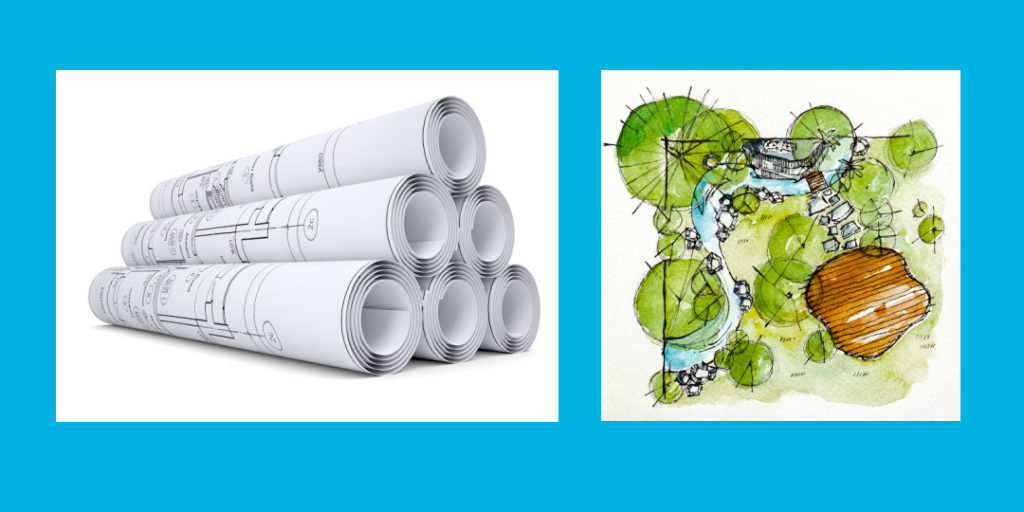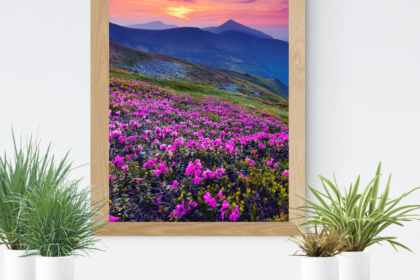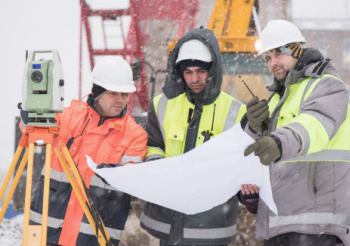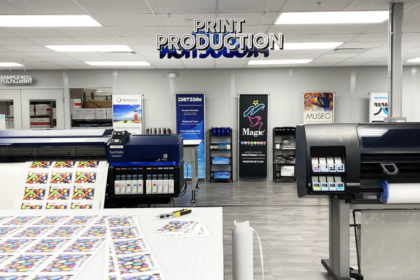Wide format plotter paper typically refers to the uncoated and coated bond papers that were originally used to make original prints or reproductions of digitally created line drawings. Plotter paper rolls and sheets were developed for use on either wide format inkjet printers or toner-based engineering copiers.
The first wide format “plotters” used computer-controlled ink pens to draw engineering or architectural designs created in computer-aided design (CAD) software. These hard-copy monochrome drawings could then be reproduced on large-format engineering copiers that used toners and xerographic digital printing technology.

Printing Output from CAD and GIS Software
Today, CAD software and printers are used by product and building engineers, construction teams, architects, interior designers, fashion designers, apparel manufacturers, exhibit builders, and artists and craftspeople who want to plan sculptures, wood carvings, and engravings.
Inkjet plotter technology also provided a method of printing multi-colored maps and images to visualize the data gathered through geographic information systems (GIS). GIS technology combines layers of data about spatial relationships, natural resources, populations, topography, and climate to help planners make better informed decisions related to urban development, forest management, mining, agriculture, military and disaster-recovery operations, facilities management, business marketing,
Types of Plotter Paper
The range of materials developed for inkjet plotters expanded as inkjet technology improved and the number of people using CAD or GIS software multiplied.
Below is a quick overview of the types of wide format plotter papers, Mylar, and overlay films available from Freedom Paper. The type of media you choose will be determined by how much ink will be applied to the paper and whether the prints will be used as first drafts or archived as permanent records.
Because wide-format plotter papers are similar to the bond papers used in desktop office printers, these wide-format papers can be used for projects other than design drawings or GIS visualizations. For example, you can use different types of bond paper rolls to output posters, charts, infographics, concept proofs for publications, or presentations of advertising designs.
Uncoated Bond Plotter Paper: This inexpensive white paper is great for printing engineering line drawings and text-only documents with matte black ink. The most budget-friendly choice is a 20 lb. Bond. Choose a 24 lb. bond if your drawings require a higher level of durability or opacity. Some 24 lb. Bond papers can be printed on both sides. A bright-white uncoated bond paper is manufactured with optical brighteners that ensure a high level of contrast between the fine black lines in a drawing and the paper.
Eco-Friendly Bond Plotter Paper: This bond paper is manufactured with at least 30% of post-consumer recycled paper. (“Post-consumer”paper has been used, discarded, and recovered from the waste stream.)
Coated Bond Plotter Paper: The surface treatment on this type of bond paper helps keep droplets of inkjet inks from sinking down into the fibers of the paper. Coated bond papers also keep inks colors from bleeding into each other. Coated papers are best for sharp, accurate printing of fine lines, small text, and multi-color drawings.
Premium Coated Bond Plotter Paper: The inkjet-receptive coatings on these 24 to 32 lb. papers are engineered to handle drawings and documents that include colorful charts or line drawings. Some premium coated bond papers have an anti-curl back coating to help prints stay flat after they are cut from the roll.
Heavyweight Presentation Plotter Paper: These 35 to 38 lb. premium coated bond papers have a higher level of opacity than lighter-weight papers. These papers can handle the heavier ink coverage in documents that contain photographs, graphics, or solid blocks of color. The ink-receptive coating on these premium bond papers supports bright, clean contrasts, rich colors, and smoother tonal gradations.
Inkjet Vellum: This 100% cotton-fiber, acid-free inkjet paper is used to make long-lasting overlays and blueprints that require high-resolution text and uniformity in solid print areas. The paper resists fading, tearing, and yellowing over time. Inkjet-printable vellum is also popular for arts and crafts projects, such as hand-crafted invitations, scrapbooks, tracing images, or making mixed-media prints.
Inkjet Translucent Bond: These lighter-weight translucent bond papers provide a budget-friendly alternative to vellum for everyday printing of overlays, blueprints, scrapbooks, and art projects.
Wide-Format Papers for Engineering Copiers
The papers in this category work best with the toners in xerographic copiers and LCD and laser printers. that use toners instead of inks. Unlike inkjet plotters, some xerographic engineering copiers require paper rolls that are taped to the core.
Opaque Bond Wide Format Plotter Paper: This white paper is an inexpensive white paper, typically used for black-ink drawings and text documents. This paper is available in 20 lb. standard-weight or 24 lb. premium-duty rolls, and can be purchased with blue, pink, green, or yellow tint. It may also be referred to as Bond Laser Paper.
Eco-friendly Bond. This bond paper is manufactured with 30 percent post-consumer recycled paper.
Translucent Bonds for Laser Printers: These papers are a great choice if you need a more affordable, non-archival translucent alternative to Mylar films or premium vellum.
Solventless and Production-Quality Vellum Paper Rolls: These 100 percent cotton-rag, archival grade papers that produce crisp lines and high-resolution images. These papers are sold in 500 ft. roll lengths.
Other Drafting Materials
Xerographic Mylar Film: This thin, polyester, translucent film provides a durable, alternative to drawing paper. It can withstand repeated revisions and mark-ups with wet-erase markers. Mylar is unaffected by humidity and temperature extremes, including the heat of engineering copiers. This dimensional stability minimizes shrinkage and image distortion and enhances the longevity of the prints. Xerographic Mylar Film is specifically designed to work with engineering copiers and laser toner printers.
Inkjet Double-Matte Mylar: These translucent films have a coating for inkjet printing on one side, and a coating for drafting on the other side. Both sides can be marked up with wet-erase markers. While this film looks and behaves almost identically to the Xerographic mylar film, it is coated specifically to be printed on with aqueous inkjet printers.
Clear Films: These optically clear films can be printed to produce informative overlays for maps and drawings.
For More Information
If you have questions about specific products, chat with us online at www.freedompaper.com. To stay informed about new products or special discounts, subscribe to our blog or newsletter.







